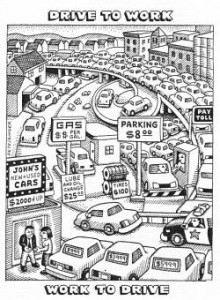Encouraging Cycling


Cycling is a safe and benign activity but cyclists are vulnerable to risk and danger caused by the speed, power, and lethality of motor vehicles. Aggressive driving is endemic in Hong Kong. Airbags and crash protection for occupants of cars encourage drivers to take more risks, thereby putting at greater risk the lives of people walking and cycling. We should be challenging the conventional wisdom of non-cyclists who say “cycling is dangerous” and target the tyranny of dangerous vehicles, including car, taxi, bus and truck drivers equally. This means campaigning for traffic calming and zero tolerance of speeding and bad driving practices such as unsafe overtaking.
2. Advance Stop Lines, or “Bike Boxes”
Now more or less standard provision in the UK (and included in the Bike Plans of cities such as Vancouver) these aid cyclists filtering to a safe riding position at traffic lights ahead of the queue and away from car exhausts.
3. On Street Bike Lanes
4. Contraflow Cycle Lanes
Many traffic management systems such as circuitous one way streets are designed for motor vehicle movement. Bicycles need exemption. Therefore facilities such as safely separated lanes in the opposite direction of the main flow should be considered in selected locations.
5. Bicycle Parking
Cyclists deserve safe and convenient parking and this need occupy only a fraction of the space currently given over to cars and motorbikes. It is grotesque that glistening new shopping malls with huge car parking facilities ban cyclists from parking outside.
6. Ferries, Trains and Buses
End the bicycle ban on the Central to Tsimshatsui Star Ferry and similar constraints on integrated transport such as the MTR and KCR’s bicycle restrictions. By comparison city transit systems like those in London, New York,Chicago, etc., welcome and encourage cycle carriage. Also we would appreciate US-style bike racks on relevant (e.g. tunnel) buses. It is ridiculous that “leisure cyclists” currently contribute to road congestion and unsustainable transport activities by loading their bikes onto cars to get to countryside cycling venues.
7. Responsible Cycling Safety Materials
Cycling literature being produced by government contains childish and uninformed statements written by people who do not ride bicycles. In fact some of the material such as directives to “ride half a metre from the kerb” actually put cyclists’ lives at risk. Safety materials based on knowledge of cyclecraft and official world class standards need to be adopted. For example refer to the UK’s “TFL safety tips” or New York’s “Give Respect/Get Respect” or the City of Toronto’s “Pass Bikes Safely”.
8. Education of Cyclists
Levels of cycling skills are poor in Hong Kong. This is precisely because cycling is treated as a marginal “leisure” activity. Government funds a Cycling Association which promotes activities such as indoor “artistic cycling” and road racing events. There is nothing inherently wrong with these activities except the air of elitism, which overlooks and discourages ordinary grassroots functional cycling. There are no cycling skill courses or proficiency tests in or out of schools. Priorities need re-ordering to promote encourage and teach cycling as a lifestyle choice, emphasising use of the bicycle as a vehicle.
9. Education of Drivers
Instead of placing on cyclists (and pedestrians) the sole burden to avoid and get out of the way of dangers caused by cars, buses and trucks, what is needed is a massive campaign to instill in drivers an awareness that they wittingly or unwittingly intimidate, threaten and endanger vulnerable road users. Drivers need to be reminded that cyclists have a right to use of the road and are entitled to occupy traffic lanes rather than be forced always to the side where the greatest dangers can occur. The current car culture glorifying power and speed encourages contempt for cycling and walking.